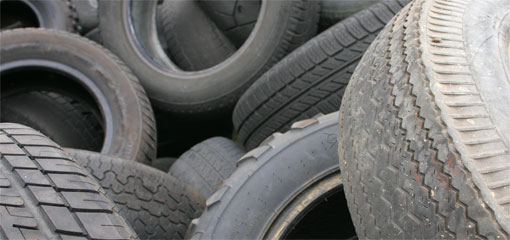When you think of a brand-new, gleaming, 2010 model car rolling out of your driveway, what materials come to mind?
Steel, chrome, soft-touch interior plastics, maybe even supple leather upholstery?
Well, how about some old carpets, ground-up milk cartons, and shredded, faded, raggedy blue jeans?

California recycles waste tires into new roads
Recycled materials: feedstock
Those materials, and more, are among the increasing amount of recycled materials that find their way into new cars these days. And the Detroit News has written a fascinating description on how the industry has--very quietly--become a lot greener in its materials choices.
As always, the motivation is money as well as eco-awareness. Suppliers are increasingly looking to new sources of raw materials, and especially during the oil price spike two years ago, recycled goods were cheaper than virgin plastics.
Plastic jugs and old tires
Almost 10 percent of the high-density polyethylene from milk jugs, detergent bottles, and other plastic containers now goes into automotive parts, according to the Association of Post-Consumer Plastics Recyclers.
Ford, for example, reuses those plastics in body shields and fender liners, along with recycled tires and the casings from old 12-Volt batteries (which are recycled at a rate of roughly 98 percent).
Soda bottles + yarn waste = seat fabric
Even seat fabrics come into the mix, with the 2010 Ford Taurus SHO (among other cars) using upholstery made from materials that include old soda bottles and yarn waste.
Ford says its use of recycled plastics diverted 25 to 30 million pounds of waste from landfills. Its recycling efforts also saved the company up to $5 million, critical when sales have plummeted and every penny counts to keep Detroit's only non-bankrupt automaker afloat.
Stuffing old jeans into gaps
The 2010 Buick LaCrosse, pride of General Motors' renovated line of Buick luxury sedans, includes acoustic ceiling panels made from discarded packaging cardboard.
GM also uses shredded denim--that's your old blue jeans--stuffed into hollows in body stampings to deaden sound, and makes door-handle brackets out of recycled carpet.
Recycling the rest of the car
Such efforts are likely to increase, especially if the price of oil continues to rise in the coming years. And recycling is now even the subject of research by government labs, including Argonne National Labs.
Researchers there are ways of recovering and reusing the 25 percent of a vehicle that isn't currently recycled after it's shredded. Of 12 million vehicles scrapped yearly, 5 million tons of material is just "shredder residue" that's now sent to landfills.

Recycled plastics to help industry cut costs













